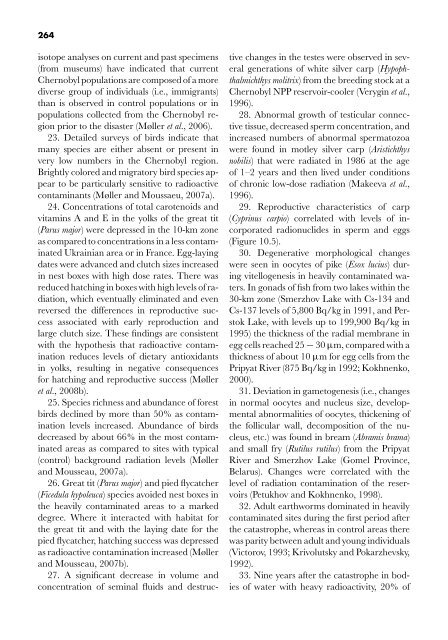PDF copy of 2009 book
PDF copy of 2009 book
PDF copy of 2009 book
Create successful ePaper yourself
Turn your PDF publications into a flip-book with our unique Google optimized e-Paper software.
264isotope analyses on current and past specimens(from museums) have indicated that currentChernobyl populations are composed <strong>of</strong> a morediverse group <strong>of</strong> individuals (i.e., immigrants)than is observed in control populations or inpopulations collected from the Chernobyl regionprior to the disaster (Møller et al., 2006).23. Detailed surveys <strong>of</strong> birds indicate thatmany species are either absent or present invery low numbers in the Chernobyl region.Brightly colored and migratory bird species appearto be particularly sensitive to radioactivecontaminants (Møller and Moussaeu, 2007a).24. Concentrations <strong>of</strong> total carotenoids andvitamins A and E in the yolks <strong>of</strong> the great tit(Parus major) were depressed in the 10-km zoneas compared to concentrations in a less contaminatedUkrainian area or in France. Egg-layingdates were advanced and clutch sizes increasedin nest boxes with high dose rates. There wasreduced hatching in boxes with high levels <strong>of</strong> radiation,which eventually eliminated and evenreversed the differences in reproductive successassociated with early reproduction andlarge clutch size. These findings are consistentwith the hypothesis that radioactive contaminationreduces levels <strong>of</strong> dietary antioxidantsin yolks, resulting in negative consequencesfor hatching and reproductive success (Mølleret al., 2008b).25. Species richness and abundance <strong>of</strong> forestbirds declined by more than 50% as contaminationlevels increased. Abundance <strong>of</strong> birdsdecreased by about 66% in the most contaminatedareas as compared to sites with typical(control) background radiation levels (Møllerand Mousseau, 2007a).26. Great tit (Parus major) and pied flycatcher(Ficedula hypoleuca) species avoided nest boxes inthe heavily contaminated areas to a markeddegree. Where it interacted with habitat forthe great tit and with the laying date for thepied flycatcher, hatching success was depressedas radioactive contamination increased (Møllerand Mousseau, 2007b).27. A significant decrease in volume andconcentration <strong>of</strong> seminal fluids and destructivechanges in the testes were observed in severalgenerations <strong>of</strong> white silver carp (Hypophthalmichthysmolitrix) from the breeding stock at aChernobyl NPP reservoir-cooler (Verygin et al.,1996).28. Abnormal growth <strong>of</strong> testicular connectivetissue, decreased sperm concentration, andincreased numbers <strong>of</strong> abnormal spermatozoawere found in motley silver carp (Aristichthysnobilis) that were radiated in 1986 at the age<strong>of</strong> 1–2 years and then lived under conditions<strong>of</strong> chronic low-dose radiation (Makeeva et al.,1996).29. Reproductive characteristics <strong>of</strong> carp(Cyprinus carpio) correlated with levels <strong>of</strong> incorporatedradionuclides in sperm and eggs(Figure 10.5).30. Degenerative morphological changeswere seen in oocytes <strong>of</strong> pike (Esox lucius) duringvitellogenesis in heavily contaminated waters.In gonads <strong>of</strong> fish from two lakes within the30-km zone (Smerzhov Lake with Cs-134 andCs-137 levels <strong>of</strong> 5,800 Bq/kg in 1991, and PerstokLake, with levels up to 199,900 Bq/kg in1995) the thickness <strong>of</strong> the radial membrane inegg cells reached 25 − 30 μm, compared with athickness <strong>of</strong> about 10 μm for egg cells from thePripyat River (875 Bq/kg in 1992; Kokhnenko,2000).31. Deviation in gametogenesis (i.e., changesin normal oocytes and nucleus size, developmentalabnormalities <strong>of</strong> oocytes, thickening <strong>of</strong>the follicular wall, decomposition <strong>of</strong> the nucleus,etc.) was found in bream (Abramis brama)and small fry (Rutilus rutilus) fromthePripyatRiver and Smerzhov Lake (Gomel Province,Belarus). Changes were correlated with thelevel <strong>of</strong> radiation contamination <strong>of</strong> the reservoirs(Petukhov and Kokhnenko, 1998).32. Adult earthworms dominated in heavilycontaminated sites during the first period afterthe catastrophe, whereas in control areas therewas parity between adult and young individuals(Victorov, 1993; Krivolutsky and Pokarzhevsky,1992).33. Nine years after the catastrophe in bodies<strong>of</strong> water with heavy radioactivity, 20% <strong>of</strong>




